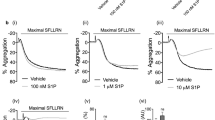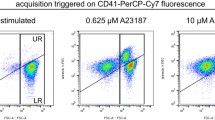Abstract
Besides its role as a putative second messenger releasing Ca2+ from intracellular stores, sphingosine-1-phosphate (SPP) has recently been identified as an extracellularly acting ligand activating a high affinity G protein-coupled membrane receptor in various cell types. Since SPP can be released from activated platelets, we examined in the present study whether endothelial cells express receptors for SPP and related sphingolipids. In bovine aortic endothelial cells loaded with fura-2, addition of SPP caused a rapid and transient increase in intracellular Ca2+ concentration ([Ca2+]i), amounting to maximally about 230 nM. Removal of extracellular Ca2+ revealed that SPP-induced [Ca2+]i elevations were due to both release of Ca2+ from intracellular stores and influx of extracellular Ca2+. Pretreatment of the cells with pertussis toxin inhibited the SPP-induced increase in [Ca2+]i by 83%, in line with the previously reported involvement of G proteins of the Gi/o family in SPP signalling in other cell types. In contrast to other [Ca2+]i-elevating agonists, e.g., ATP and bradykinin, SPP did not activate phospholipase C in bovine aortic endothelial cells, suggesting the involvement of a novel, unidentified signalling pathway in SPP-induced release of intracellular Ca2+. Furthermore, SPP also did not cause activation of either phospholipase D or A2. Out of various related sphingolipids studied, only sphingosylphosphorylcholine (SPPC) induced a similar maximal increase in [Ca2+ i as SPP, and its effect was also fully pertussis toxin-sensitive. However, the potencies of the two sphingolipids to increase [Ca2+]i differed by more than two orders of magnitude, with the EC50 values being 0.8 nM and 260 nM for SPP and SPPC, respectively. These results identify SPP and SPPC as novel and potent endothelial agonists, inducing calcium signalling by activation of a Gi/o protein-coupled receptor(s). Given the recently reported release of SPP from thrombin-activated platelets, SPP may represent a novel mediator of platelet-endothelial cell interactions.
Similar content being viewed by others
References
Bornfeldt KE, Graves LM, Raines EW, Igarashi Y, Wayman G, Yamamura S, Yatomi Y, Sidhu IS, Krebs EG, Hakomori S, Ross R (1995) Sphingosine-1-phosphate inhibits PDGF-induced chemotaxis of human arterial smooth muscle cells: spatial and temporal modulation of PDGF chemotactic signal transduction. J Cell Biol 130:193–206
Bradford MM (1976) A rapid and sensitive method for the quantitation of microgram quantities of protein utilizing the principle of protein-dye binding. Anal Biochem 72:248–254
Buckley BJ, Barchowsky A, Dolor RJ, Whorton AR (1991) Regulation of arachidonic acid release in vascular endothelium. Ca2+-dependent and -independent pathways. Biochem J 280:281–287
Bünemann M, Brandts B, Meyer zu Heringdorf D, van Koppen CJ, Jakobs KH, Port L (1995) Activation of muscarinic K+ current in guinea-pig atrial myocytes by sphingosine-1-phosphate. J Physiol 489:701–707
Chao CP, Laulederkind SJF, Ballou LR (1994) Sphingosine-mediated phosphatidylinositol metabolism and calcium mobilization. J Biol Chem 269:5849–5856
Desai NN, Zhang H, Olivera A, Mattie ME, Spiegel S (1992) Sphingosine-1-phosphate, a metabolite of sphingosine, increases phosphatidic acid levels by phospholipase D activation. J Biol Chem 267:23122–23128
Desai NN, Carlson RO, Mattie ME, Olivera A, Buckley NE, Seki T, Brooker G, Spiegel S (1993) Signaling pathways for sphingosylphosphorylcholine-mediated mitogenesis in Swiss 3T3 fibroblasts. J Cell Biol 121:1385–1395
Frelin C, Breittmayer JP, Vigne P (1993) ADP induces inositol phosphate-independent intracellular Ca2+ mobilization in brain capillary endothelial cells. J Biol Chem 268:8787–8792
Galione A (1993) Cyclic ADP-ribose: a new way to control calcium. Science 259:325–326
Ghosh TK, Bian J, Gill DL (1994) Sphingosine-1-phosphate generated in the endoplasmic reticulum membrane activates release of stored calcium. J Biol Chem 269:22628–22635
Goodemote KA, Mattie ME, Berger A, Spiegel S (1995) Involvement of a pertussis toxin-sensitive G protein in the mitogenic signaling pathways of sphingosine-1-phosphate. J Biol Chem 270:10272–10277
Hannun YA (1994) The sphingomyelin cycle and the second messenger function of ceramide. J Biol Chem 269:3125–3128
Hannun YA, Linardic CM (1993) Sphingolipid breakdown products: anti-proliferatioe and tumor-suppressor lipids. Biochim Biophys Acta 1154:223–236
Himmel HM, Whorton AR, Strauss HC (1993) Intracellular calcium, currents, and stimulus-response coupling in endothelial cells. Hypertension 21:112–127
Himmel HM, Rasmusson RL, Strauss HC (1994) Agonist-induced changes of [Ca2+ i and membrane currents in single bovine aortic endothelial cells. Am J Physiol 267:C1338-C1350
Kim S, Lakhani V, Costa DJ, Sharara AI, Fitz JG, Huang L-W, Peters KG, Kindman LA (1995) Sphingolipid-gated Ca2+ release from intracellular stores of endothelial cells is mediated by a novel Ca2+-permeable channel. J Biol Chem 270:5266–5269
Kindman LA, Kim S, McDonald TV, Gardner P (1994) Characterization of a novel intracellular sphingolipid-gated Ca2+-permeable channel from rat basophilic leukemia cells. J Biol Chem 269:13088–13091
Kolesnick R, Golde DW (1994) The sphingomyelin pathway in tumor necrosis factor and interleukin-1 signaling. Cell 77:325–328
Mattie M, Brooker G, Spiegel S (1994) Sphingosine-1-phosphate, a putative second messenger, mobilizes calcium from internal stores via an inositol trisphosphate-independent pathway. J Biol Chem 269:3181–3188
Michel MC, Feth F, Stieneker M, Rascher W (1992) NPY and carbachol raise Ca2+ in SK-N-MC cells by three different mechanisms. Evidence for inositol phosphate-independent Ca2+ mobilization by NPY. Naunyn-Schmiedeberg's Arch Pharmacol 345:370–374
Michell RH, Wakelam MJO (1994) Sphingolipid signalling. Curr Biol 4:370–373
Motte S, Pirotton S, Boeynaems JM (1993) Heterogeneity of ATP receptors in aortic endothelial cells. Involvement of P2y and P2u receptors in inositol phosphate response. Circ Res 72:504–510
Natarajan V, Jayaram HN, Scribner WM, Garcia JGN (1994) Activation of endothelial cell phospholipase D by sphingosine and sphingosine-1-phosphate. Am J Respir Cell Mol Biol 11:221–229
Newby AC, Henderson AH (1990) Stimulus-secretion coupling in vascular endothelial cells. Annu Rev Physiol 52:661–674
Okajima F, Kondo Y (1995) Pertussis toxin inhibits phospholipase C activation and Ca2+ mobilization by sphingosylphosphorylcholine and galactosylsphingosine in HL60 leukemia cells. Implications of GTP-binding protein-coupled receptors for lysosphingolipids. J Biol Chem 270:26332–26340
Olivera A, Spiegel S (1993) Sphingosine-1-phosphate as second messenger in cell proliferation induced by PDGF and FCS mitogens. Nature 365:557–560
Sa G, Murugesan G, Jaye M, Ivashchenko Y, Fox PL (1995) Activation of cytosolic phospholipase A2 by basic fibroblast growth factor via a p42 mitogen-activated protein kinase-dependent phosphorylation pathway in endothelial cells. J Biol Chem 270:2360–2366
Schmidt M, Bienek C, van Koppen CJ, Michel MC, Jakobs KH (1995) Differential calcium signalling by m2 and m3 muscarinic acetylcholine receptors in a single cell type. Naunyn-Schmiedeberg's Arch Pharmacol 352:469–476
Schmidt M, Huwe SM, Fasselt B, Homann D, Rümenapp U, Sandmann J, Jakobs KH (1994) Mechanisms of phospholipase D stimulation by m3 muscarinic acetylcholine receptors. Evidence for involvement of tyrosine phosphorylation. Eur J Biochem 225:667–675
Seufferlein T, Rozengurt E (1995) Sphingosylphosphorylcholine activation of mitogen-activated protein kinase in Swiss 3T3 cells requires protein kinase C and a pertussis toxin-sensitive G protein. J Biol Chem 270:24334–24342
Siffert W, Rosskopf D, Moritz A, Wieland T, Kaldenberg-Stasch S, Kettler N, Hartung K, Beckmann S, Jakobs KH (1995) Enhanced G protein activation in immortalized lymphoblasts from patients with essential hypertension. J Clin Invest 96:759–766
Spiegel S, Milstien S (1995) Sphingolipid metabolites: members of a new class of lipid second messengers. J Membr Biol 146:225–237
Spiegel S, Olivera A, Carlson RO (1993) The role of sphingosine in cell growth regulation and transmembrane signaling. Adv Lipid Res 26:105–129
Törnquist K, Ekokoski E (1994) Effect of sphingosine derivatives on calcium fluxes in thyroid FRTL-5 cells. Biochem J 299:213–218
van Koppen CJ, Meyer zu Heringdorf D, Laser KT, Zhang C, Jakobs KH, Bünemann M, Pott L (1996a) Activation of a high affinity Gi protein-coupled plasma membrane receptor by sphingosine-1-phosphate. J Biol Chem 271:2082–2087
van Koppen CJ, Meyer zu Heringdorf D, Zhang C, Laser KT, Jakobs KH (1996b) A distinct G; protein-coupled receptor for sphingosylphosphorylcholine in human leukemia HL-60 cells and human neutrophils. Mol Pharmacol 49:956–961
Wu J, Spiegel S, Sturgill TW (1995) Sphingosine-1-phosphate rapidly activates the mitogen-activated protein kinase pathway by a G protein-dependent mechanism. J Biol Chem 270:11484–11488
Yatorni Y, Ruan F, Hakomori S, Igarashi Y (1995) Sphingosine-1-phosphate: a platelet-activating sphingolipid released from agonist-stimulated human platelets. Blood 86:193–202
Zhang H, Desai NN, Olivera A, Seki T, Brooker G, Spiegel S (1991) Sphingosine-1-phosphate, a novel lipid, involved in cellular proliferation. J Cell Biol 114:155–167
Author information
Authors and Affiliations
Rights and permissions
About this article
Cite this article
zu Heringdorf Meyer, D., van Koppen, C.J., Windorfer, B. et al. Calcium signalling by G protein-coupled sphingolipid receptors in bovine aortic endothelial cells. Naunyn-Schmiedeberg's Arch Pharmacol 354, 397–403 (1996). https://doi.org/10.1007/BF00168428
Received:
Accepted:
Issue Date:
DOI: https://doi.org/10.1007/BF00168428




